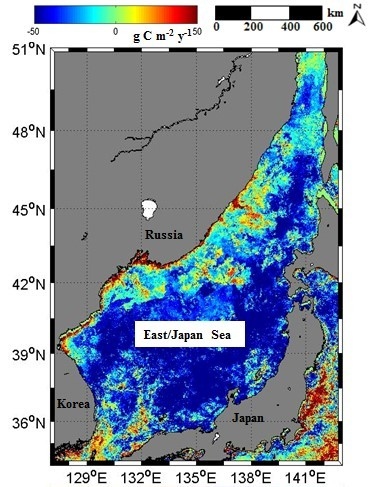Long-Term Pattern of Primary Productivity in the East/Japan Sea Based on Ocean Color Data Derived from MODIS-Aqua
Abstract
:1. Introduction
2. Materials and Methods
2.1. Satellite Ocean Color Data

2.2. Primary Productivity Algorithm
3. Results
3.1. Temporal Variations of Euphotic Depths

3.2. Spatial and Temporal Variation of MODIS-Derived Chl-a
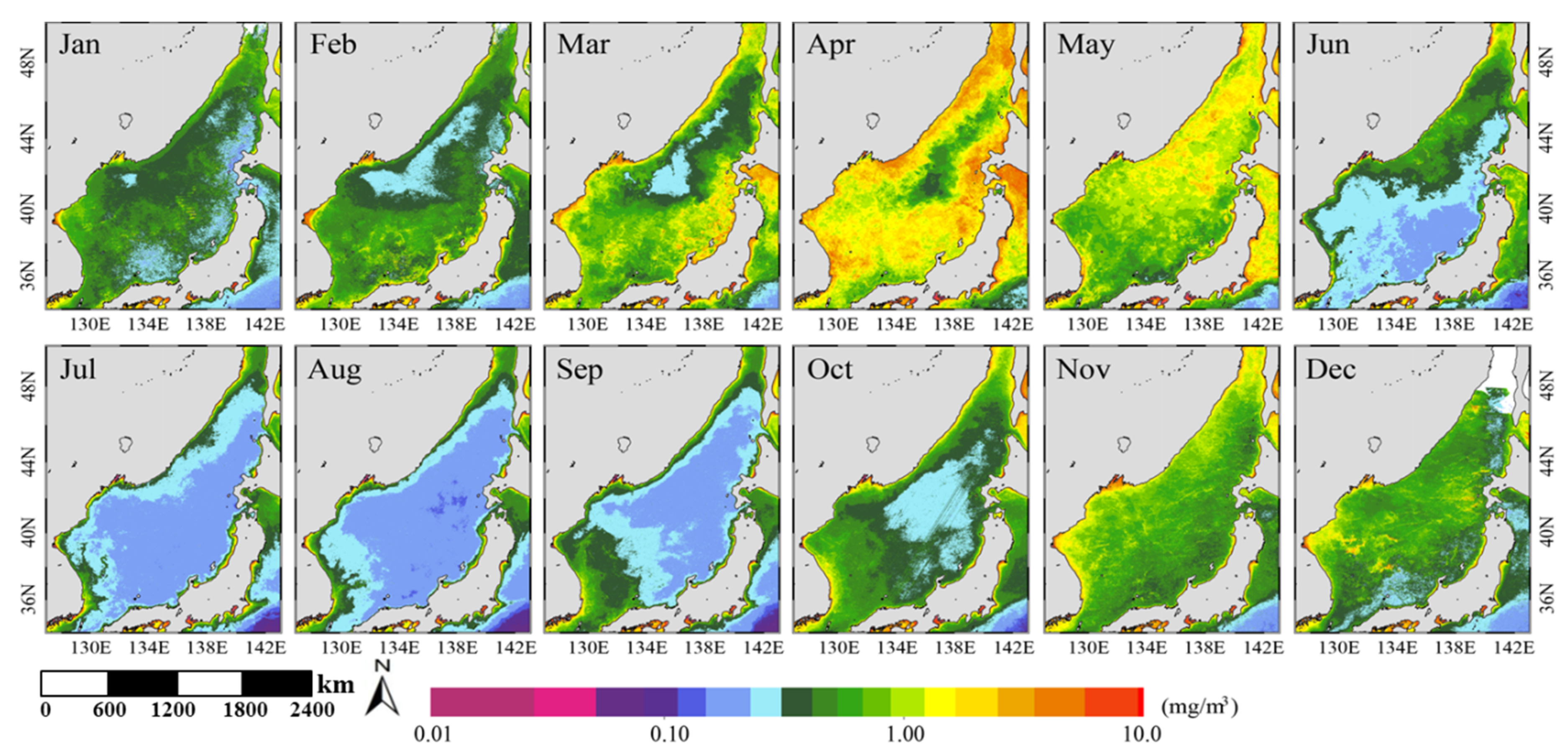
3.3. Spatial and Temporal Variation of MODIS-Derived Primary Productivity
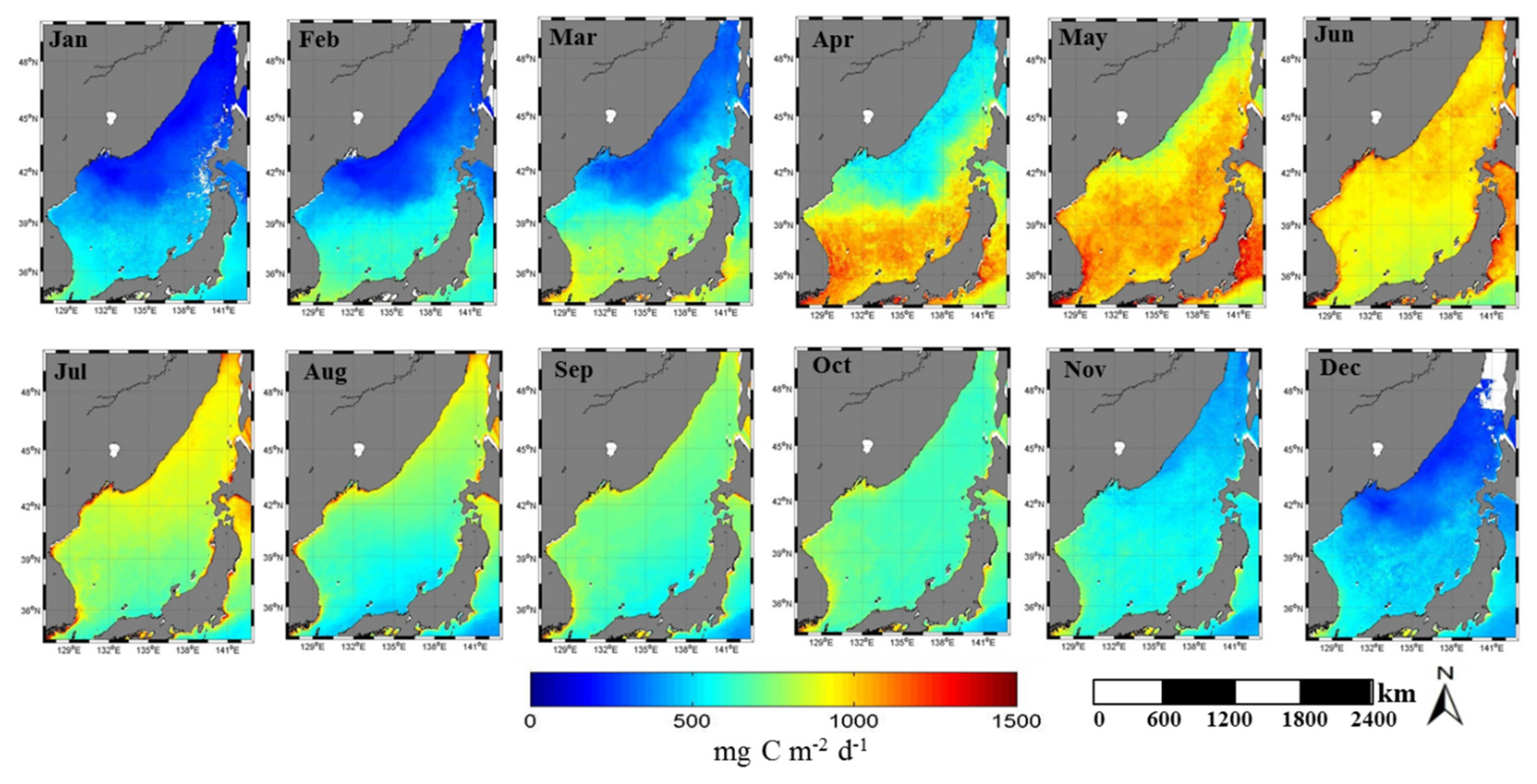
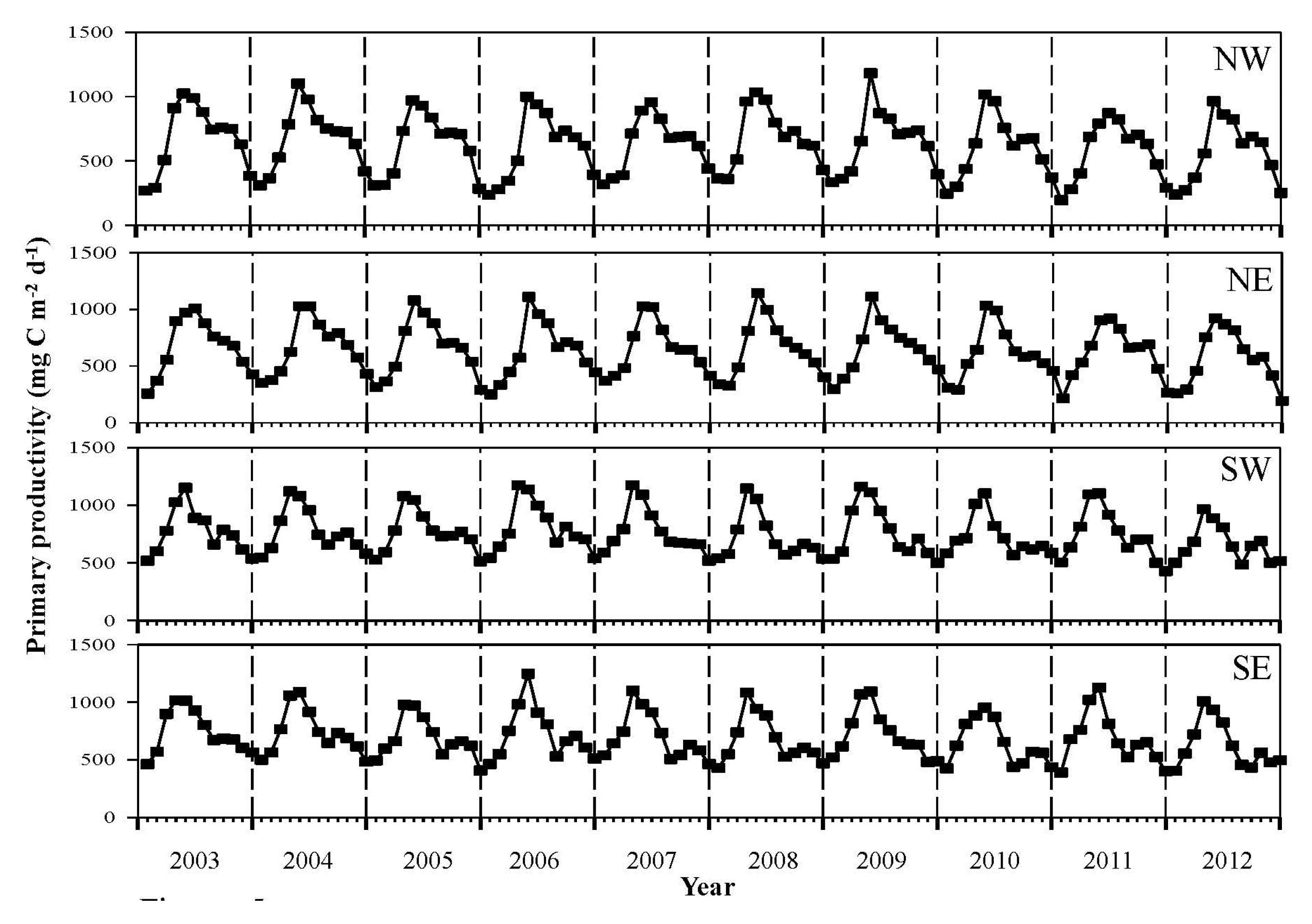
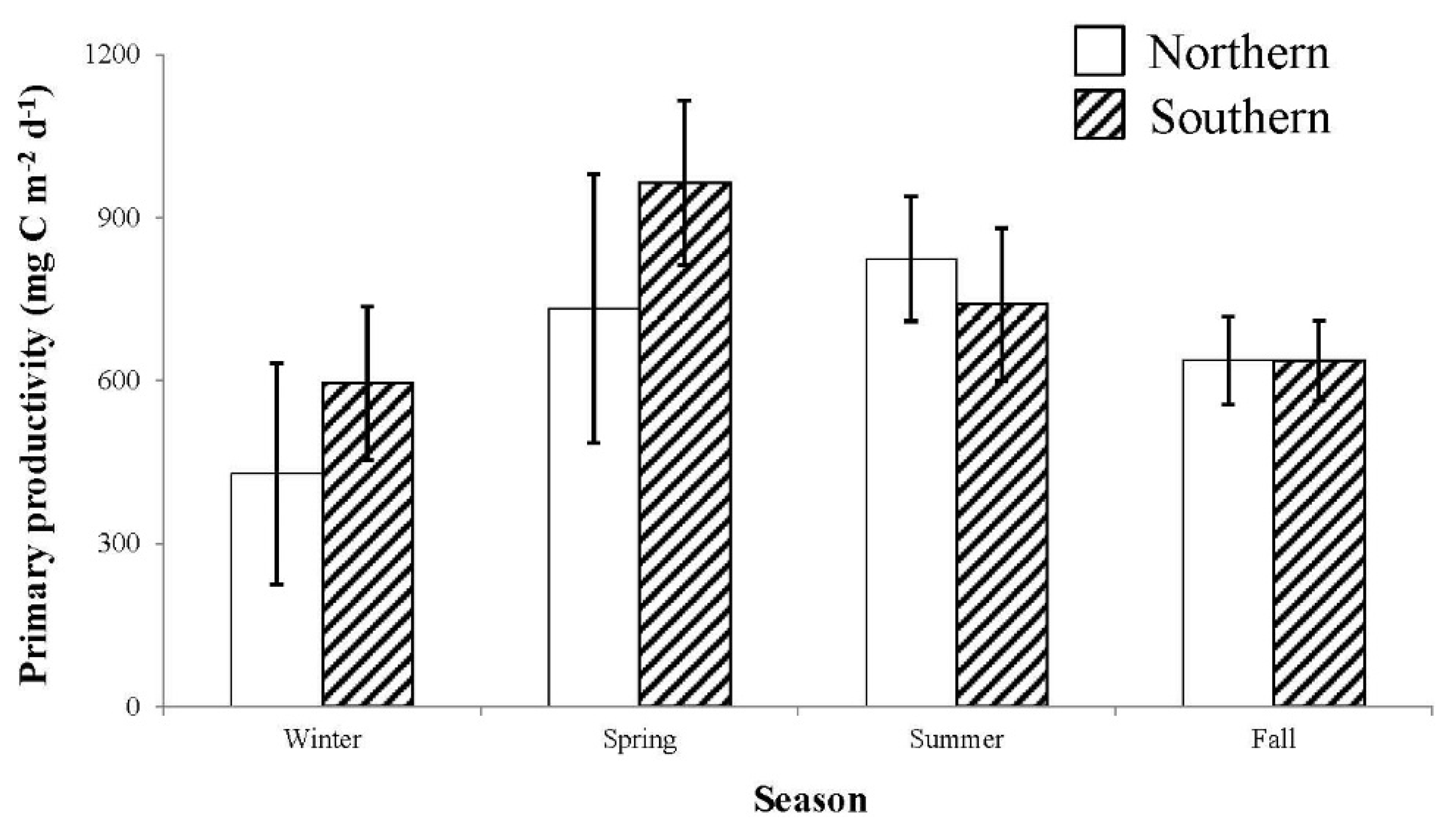
3.4. Long-Term Variation of the Annual Primary Production in the East Sea

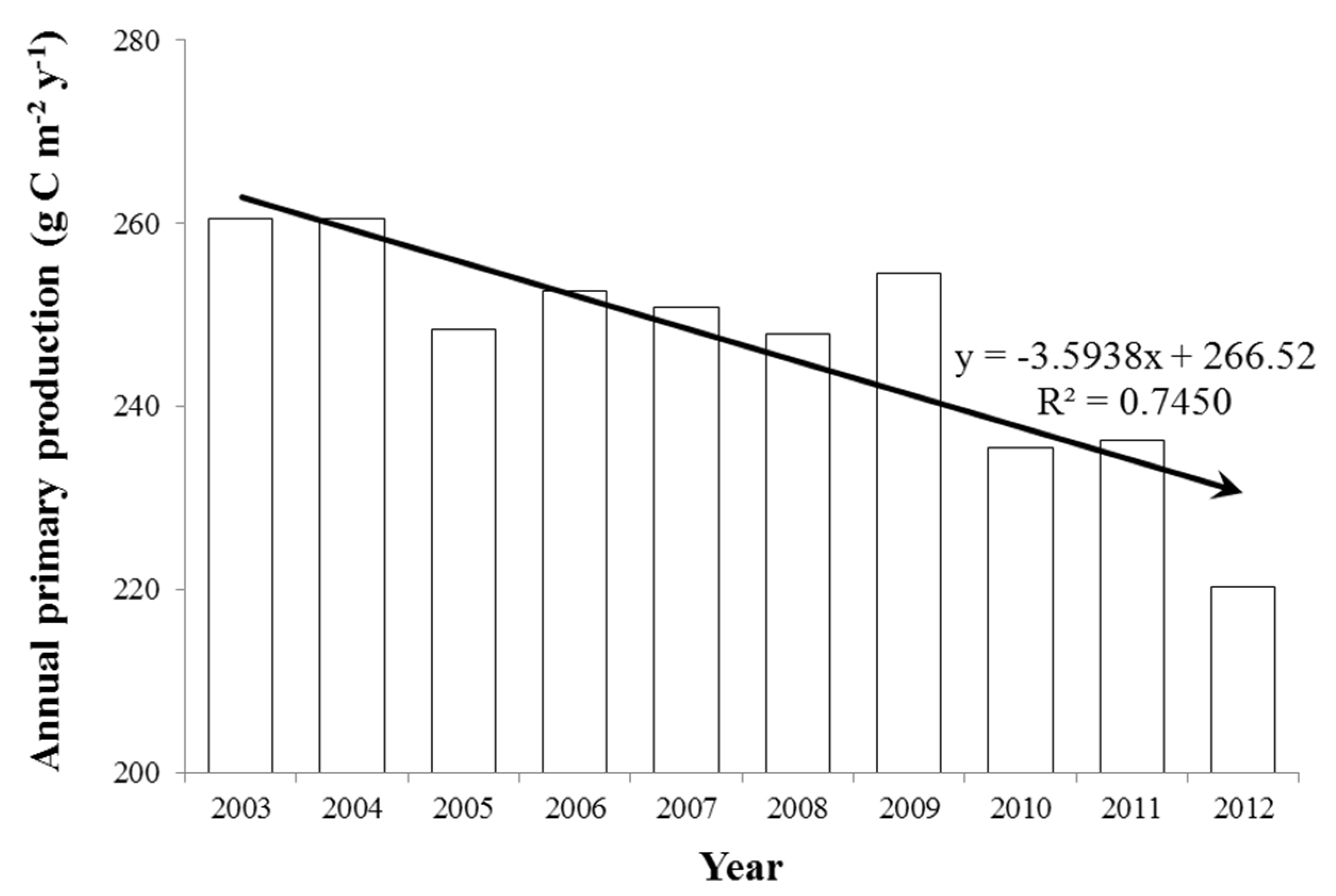

4. Discussion
4.1. The Spatial and Seasonal Variations in Chl-a Concentrations in the East Sea
4.2. Primary Productivity in the East Sea
| Month | NW (%) | NE (%) | SW (%) | SE (%) | East Sea (%) |
|---|---|---|---|---|---|
| 1 | 3.8 | 3.9 | 6.0 | 5.6 | 4.9 |
| 2 | 4.2 | 4.7 | 7.0 | 7.2 | 5.8 |
| 3 | 5.7 | 6.4 | 8.8 | 9.2 | 7.7 |
| 4 | 9.5 | 9.6 | 12.2 | 12.3 | 11.0 |
| 5 | 13.2 | 13.5 | 12.0 | 12.5 | 12.8 |
| 6 | 12.4 | 12.7 | 10.0 | 10.6 | 11.3 |
| 7 | 11.0 | 11.0 | 8.5 | 8.7 | 9.7 |
| 8 | 9.1 | 9.1 | 7.0 | 6.6 | 7.9 |
| 9 | 9.5 | 8.8 | 7.7 | 7.2 | 8.3 |
| 10 | 9.1 | 8.5 | 7.9 | 7.7 | 8.3 |
| 11 | 7.6 | 6.8 | 6.9 | 6.8 | 7.0 |
| 12 | 4.9 | 5.0 | 5.9 | 5.7 | 5.4 |
4.3. Long-Term Pattern of the Annual Primary Production in the East Sea
5. Conclusions
Acknowledgments
Author Contributions
Conflicts of Interest
References
- Onitsuka, G.; Yanagi, T.; Yoon, J.H. A numerical study on nutrient sources in the surface layer of the Japans Sea using a coupled physical-ecosystem model. J. Geophys. Res. 2007, 112, C05042. [Google Scholar] [CrossRef]
- Kang, Y.S.; Kim, J.Y.; Kim, H.G.; Park, J.H. Long_term changes in zooplankton and its relation_ship with squid, Todarodes pacificus, catch in Japan/East Sea. Fish. Oceanogr. 2002, 11, 337–346. [Google Scholar] [CrossRef]
- Kim, D.; Yang, E.J.; Kim, K.H.; Shin, C.-W.; Park, J.; Yoo, S.; Hyun, J.-H. Impact of an anticyclonic eddy on the summer nutrient and Chl-a a distributions in the Ulleung Basin, East Sea (Japan Sea). ICES J. Mar. Sci. 2012, 69, 23–29. [Google Scholar] [CrossRef]
- Lim, J.-H.; Son, S.; Park, J.-W.; Kwak, J.H.; Kang, C.-K.; Son, Y.B.; Kwon, J.-N.; Lee, S.H. Enhanced biological activity by an anticyclonic warm eddy during early spring in the East Sea (Japan Sea) detected by the geostationary ocean color satellite. Ocean Sci. J. 2012, 47, 377–385. [Google Scholar] [CrossRef]
- Chiba, S.; Aita, M.N.; Tadokoro, K.; Saino, T.; Sugisaki, H.; Nakata, K. From climate regime shifts to lower-trophic level phenology: Synthesis of recent progress in retrospective studies of the western North Pacific. Prog. Oceanogr. 2008, 77, 112–126. [Google Scholar] [CrossRef]
- Kim, K.-R.; Kim, K.; Kang, D.-J.; Park, S.Y.; Park, M.-K.; Kim, Y.-G.; Min, H.S.; Min, D. The East Sea (Japan Sea) in change: A story of dissolved oxygen. Mar. Technol. Soc. J. 1999, 33, 15–22. [Google Scholar] [CrossRef]
- Kim, K.; Kim, K.-R.; Min, D.-H.; Volkov, Y.; Yoon, J.-H.; Takematsu, M. Warming and structural changes in the East (Japan) Sea: A clue to future changes in global oceans? Geophys. Res. Lett. 2001, 28, 3293–3296. [Google Scholar] [CrossRef]
- Kang, D.J.; Park, S.; Kim, Y.G.; Kim, K.; Kim, K.-R. A moving-boundary box model (MBBM) for oceans in change: An application to the East/Japan Sea. Geophys. Res. Lett. 2003, 30, 1299. [Google Scholar] [CrossRef]
- Sasaoka, K.; Chiba, S.; Saino, T. Climatic forcing and phytoplankton phenology over the subarctic North Pacific from 1998 to 2006, as observed from ocean color data. J. Geophys. Lett. 2011, 38, L15609. [Google Scholar] [CrossRef]
- Chiba, S.; Batten, S.; Sasaoka, K.; Sasai, Y.; Sugisaki, H. Influence of the Pacific Decadal Oscillation on phytoplankton phenology and community structure in the western North Pacific. Geophys. Res. Lett. 2012, 39, L15603. [Google Scholar] [CrossRef]
- Chiba, S.; Saino, T. Variation in mesozooplankton community structure in the Japan/East Sea (1991–1999) with possible influence of the ENSO scale climatic variability. Prog. Oceanogr. 2002, 213, 23–25. [Google Scholar] [CrossRef]
- Zhang, C.I.; Lee, J.B.; Young, I.S.; Yoon, S.C.; Kim, S. Variations in the abundance of fisheries resources and ecosystem structure in the Japan/East Sea. Prog. Oceanogr. 2004, 61, 245–265. [Google Scholar] [CrossRef]
- Joo, H.; Park, J.W.; Son, S.; Noh, J.-H.; Jeong, J.-Y.; Kwak, J.H.; Saux-Picart, S.; Choi, J.H.; Kang, C.-K.; Lee, S.H. Long-term annual primary production in the Ulleung Basin as a biological hot spot in the East/Japan Sea. J. Geophys. Res. Oceans 2014, 119, 3002–3011. [Google Scholar] [CrossRef]
- Grebmeier, J.M.; Bluhm, B.A.; Cooper, L.W.; Danielson, S.L.; Arrigo, K.R.; Blanchard, A.I.; Clarke, J.T.; Day, R.H.; Frey, K.E.; Gradinger, R.R.; et al. Ecosystem characteristics and processes facilitating persistent macrobenthic biomass hotspots and associated benthivory in the Pacific Arctic. Prog. Oceanogr. 2015, 136, 92–114. [Google Scholar] [CrossRef]
- Lee, S.H.; Joo, H.T.; Lee, J.H.; Kang, J.J.; Lim, J.-H.; Yun, M.S.; Lee, J.H.; Kang, C.-K. Potential overestimation in primary and new productivitys of phytoplankton from a short time incubation method. Ocean Sci. J. 2015, 50, 509–517. [Google Scholar] [CrossRef]
- Platt, T.; Sathyendranath, S. Oceanic primary productivity: Estimation by remote sensing at local and regional scales. Science 1988, 241, 1613–1620. [Google Scholar] [CrossRef] [PubMed]
- Behrenfeld, M.J.; Falkowski, P.G. Photosynthetic rates derived from satellite-based Chl-a concentration. Limnol. Oceanogr. 1997, 42, 1–20. [Google Scholar] [CrossRef]
- Son, S.; Campbell, J.; Dowell, M.; Yoo, S.; Noh, J. Primary productivity in the Yellow Sea determined by ocean color remote sensing. Mar. Ecol. Prog. Ser. 2005, 303, 91–103. [Google Scholar] [CrossRef]
- Yamada, K.; Ishizaka, J.; Nagata, H. Spatial and temporal variability of satellite primary productivity in the Japan Sea from 1998 to 2002. J. Oceanogr. 2005, 61, 857–869. [Google Scholar] [CrossRef]
- Lee, S.H.; Son, S.; Dahms, H.-U.; Park, J.W.; Lim, J.-H.; Noh, J.-H.; Kwon, J.-I.; Joo, H.T.; Jeong, J.Y.; Kang, C.-K. Decadal changes of phytoplankton Chl-a-a in the East Sea/Sea of Japan. Oceanology 2014, 6, 771–779. [Google Scholar] [CrossRef]
- Helbling, E.W.; Villafañe, V.E. Phytoplankton and primary productivity. In Fisheries and Aquaculture; Safran, P., Ed.; Eolss Publishers: Paris, France, 2009; Volume 5. [Google Scholar]
- Wassmann, P.; Duarte, C.M.; Agusti, S.; Sejr, M.K. Footprints of climate change in the Arctic marine ecosystem. Glob. Chang. Biol. 2011, 17, 1235–1249. [Google Scholar] [CrossRef]
- Arrigo, K.R.; Dijken, G.L.V. Continued increases in Arctic Ocean primary productivity. Prog. Ocenogr. 2015, 136, 60–70. [Google Scholar] [CrossRef]
- Falkowski, P.G.; Rave, J.A. Aquatic Photosynthesis, 2nd ed.; Blackwell: Oxford, UK, 1997. [Google Scholar]
- Yoder, J.A.; Kennelly, M.A. Seasonal and ENSO variability in global ocean phytoplankton Chl-a derived from 4 years of Sea WiFS measurements. Glob. Biogeochem. Cycles 2003, 17, 1112. [Google Scholar] [CrossRef]
- Kameda, T. Studies on oceanic primary productivity using ocean color remote sensing data. Bull. Fish. Res. Agency 2003, 9, 118–148. [Google Scholar]
- Kameda, T.; Ishizaka, J. Size-fractionated primary productivity estimated by a two-phytoplankton community model applicable to ocean color remote sensing. J. Oceanogr. 2005, 61, 663–672. [Google Scholar] [CrossRef]
- Kirt, J.T.O. Light and Photosynthesis in Aquatic Ecosystems, 2nd ed.; Cambridge University Press: Cambridge, UK, 1994. [Google Scholar]
- Cushing, D.H. The seasonal variation in oceanic productivity as a problem in population dynamics. J. Cons. Int. Explor. Mer. 1959, 24, 455–464. [Google Scholar] [CrossRef]
- Son, S. The Chl-a Pigment Distribution in the East/Japan Sea Observed by Coastal Zone Color Scanner (CZCS). Master’s Thesis, Pusan National University, Busan, Korea, 1998. [Google Scholar]
- Yamada, K.; Ishizaka, J.; Yoo, S.; Kim, H.-C.; Chiba, S. Seasonal and interannual variability of sea surface Chl-a a concentration in the Japan/East Sea (JES). Prog. Oceanogr. 2004, 61, 193–211. [Google Scholar] [CrossRef]
- Senjyu, T. The Japan Sea intermediate water; characteristics and circulation. J. Oceanogr. 1999, 55, 111–122. [Google Scholar] [CrossRef]
- Ashjian, C.J.; Davis, C.S.; Gallager, S.M.; Alatalo, P. Characterization of the zooplankton community, size composition, and distribution in relation to hydrography in the Japan/East Sea. Deep Sea Res. II 2005, 52, 1363–1392. [Google Scholar] [CrossRef]
- Nishimura, S. Okhotsk Sea, Japan Sea, East China Sea. In Estuaries and Enclosed Seas; Ketchum, B.H., Ed.; Elsevier Scientific Publishing Company: Amsterdam, The Netherlands, 1983; pp. 375–401. [Google Scholar]
- Nagata, H. The relationship between Chl-a a and transparency in the southern Japan Sea. Proc. Jpn. Sci. Coun. Fish. Resour. 1992, 28, 29–44. [Google Scholar]
- Yoo, S.; Kim, H.C. Primary productivity in the East Sea. In The Plankton Ecology of Korean Coastal Waters; Choi, J.K., Ed.; Dongwha Press: Seoul, Korea, 2003; pp. 96–111. [Google Scholar]
- Estrada, M. Primary productivity in the northwestern Mediterranean. Sci. Mar. 1996, 60, 55–64. [Google Scholar]
- Sarmiento, J.L.; Hughes, T.M.C.; Stouffer, R.J.; Manabe, S. Simulated response of the ocean carbon cycle to anthropogenic climate warming. Nature 1998, 393, 245–249. [Google Scholar] [CrossRef]
- Gregg, W.W.; Conkright, M.E.; Ginoux, P.; O’Reilly, J.E.; Casey, N.W. Ocean Primary productivity and climate: Global decadal changes. Geophys. Res. Lett. 2003, 15, 1809. [Google Scholar] [CrossRef]
- Jo, Y.H.; Breaker, L.C.; Tseng, Y.-H.; Yeh, S.-W. A temporal multiscale analysis of the waters off the east coast of south Korea over the past four decades. Terr. Atoms. Ocean. Sci. 2014, 3, 415–434. [Google Scholar] [CrossRef]
- Gregg, W.W.; Conkright, M.E. Decadal changes in global ocean Chl-a. Geophys. Res. Lett. 2002, 29, 130. [Google Scholar] [CrossRef]
- Yatsu, A.; Chiba, S.; Yamanaka, Y.; Ito, S.I.; Shimize, Y.; Kaeriyama, M.; Watanabe, Y. Climate forcing and the Kuroshio/Oyashio ecosystem. ICES J. Mar. Sci. 2013, 70, 922–933. [Google Scholar] [CrossRef]
- Nixon, S.; Thomas, A. On the size of the Peru upwelling ecosystem. Deep Sea Res. I 2001, 48, 2521–2528. [Google Scholar] [CrossRef]
© 2015 by the authors; licensee MDPI, Basel, Switzerland. This article is an open access article distributed under the terms and conditions of the Creative Commons by Attribution (CC-BY) license (http://creativecommons.org/licenses/by/4.0/).
Share and Cite
Joo, H.; Son, S.; Park, J.-W.; Kang, J.J.; Jeong, J.-Y.; Lee, C.I.; Kang, C.-K.; Lee, S.H. Long-Term Pattern of Primary Productivity in the East/Japan Sea Based on Ocean Color Data Derived from MODIS-Aqua. Remote Sens. 2016, 8, 25. https://doi.org/10.3390/rs8010025
Joo H, Son S, Park J-W, Kang JJ, Jeong J-Y, Lee CI, Kang C-K, Lee SH. Long-Term Pattern of Primary Productivity in the East/Japan Sea Based on Ocean Color Data Derived from MODIS-Aqua. Remote Sensing. 2016; 8(1):25. https://doi.org/10.3390/rs8010025
Chicago/Turabian StyleJoo, HuiTae, SeungHyun Son, Jung-Woo Park, Jae Joong Kang, Jin-Yong Jeong, Chung Il Lee, Chang-Keun Kang, and Sang Heon Lee. 2016. "Long-Term Pattern of Primary Productivity in the East/Japan Sea Based on Ocean Color Data Derived from MODIS-Aqua" Remote Sensing 8, no. 1: 25. https://doi.org/10.3390/rs8010025





